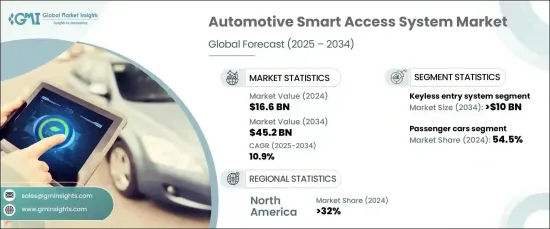
세계의 자동차용 스마트 액세스 시스템 시장 규모는 2024년에 166억 달러가 되었으며, 2025년부터 2034년에 걸쳐 CAGR 10.9%라는 경이적인 성장을 이룰 것으로 예측되고 있습니다.
이러한 강력한 성장은 주로 차량에 대한 침입, 도난, 무단 접근에 대한 우려 증가로 인한 것입니다. 이에 따라 소비자와 자동차 제조업체 모두 차량과 그 내용물을 보호하기 위한 고급 보안 솔루션을 선호하게 되었습니다. 생체인증, 열쇠가 없는 입장, 원격 차량 추적과 같은 최첨단 기술은 보호를 강화하기 위해 통합되었습니다. 이러한 시스템은 최첨단 암호화 및 인증 방법을 채택하여 허가된 개인만 차량에 접근하고 운영할 수 있도록 합니다.

스마트 액세스 시스템은 차량의 보안, 편의성 및 사용자 경험을 향상시키는 능력으로 빠르게 확산되고 있습니다. IoT, 블루투스 저에너지(BLE), NFC, 클라우드 기반 솔루션 등 첨단 기술의 통합으로 차량은 고도로 연결된 지능형 장치로 변모하고 있습니다. 생체인증, 푸시버튼 스타트, 키리스 엔트리, 스마트폰과의 통합 등의 주요 기능은 드라이버와 자동차와의 관계에 혁명을 가져오고 있습니다. 이러한 기술 혁신은 기존의 키를 필요로 하지 않고, 사용자는 자동차의 잠금 해제, 시동, 제어를 원활하게 할 수 있어 탁월한 편의성과 운전 체험의 합리화를 실현합니다.
| 시장 범위 | |
|---|---|
| 시작 연도 | 2024년 |
| 예측 연도 | 2025-2034년 |
| 시작 금액 | 166억 달러 |
| 예측 금액 | 452억 달러 |
| CAGR | 10.9% |
시장은 푸시 버튼 시동 시스템, 키리스 엔트리 시스템, 생체인식 시스템, 스마트폰과의 통합, 원격 액세스 및 추적 등 이용되는 기술에 따라 구분됩니다. 2024년에는 키리스 엔트리 시스템이 시장을 독점하고 점유율의 27%를 차지하며 큰 기세를 차지했습니다. 2034년까지 이 분야는 100억 달러에 이를 것으로 예측되며, 이는 보안과 편의성을 모두 제공하는 이러한 시스템의 보급과 효과에 힘입었기 때문입니다.
차량 유형별로 분류하면 이 시장에는 승용차, 상용차 및 오프 고속도로 차량이 포함됩니다. 승용차는 2024년에 54.5%로 최대의 점유율을 차지했는데, 고급 보안과 편리성 기능에 대한 수요의 급증이 그 원동력이 되었습니다. 승용차는 세계 자동차 보유 대수의 대부분을 차지하고 있기 때문에 키리스 엔트리, 푸시 버튼 시동, 스마트폰 접속 등의 스마트 액세스 기술이 표준화되고 있어 소비자의 기대의 진화에 대응하고 있습니다.
북미의 자동차용 스마트 액세스 시스템 시장은 2024년 세계 점유율의 32%를 차지해, 이 지역의 선진적인 자동차 산업과 프리미엄에서 커넥티드한 자동차에 대한 높은 소비자 수요에 기여했습니다. 자동차의 안전성과 편리성이 중시되는 가운데, 키리스 엔트리나 생체인식 액세스 등의 기능의 채용이 계속 증가하고 있습니다. 게다가 최신 스마트 기술을 통합한 전기자동차의 인기가 높아지고 있는 것도 이 지역 시장 확대에 크게 기여하고 있습니다.
보고서 내용
The Global Automotive Smart Access System Market was valued at USD 16.6 billion in 2024 and is forecasted to grow at an impressive CAGR of 10.9% from 2025 to 2034. This robust growth is primarily driven by increasing concerns over vehicle break-ins, theft, and unauthorized access. In response, both consumers and automakers are prioritizing advanced security solutions to protect vehicles and their contents. Cutting-edge technologies such as biometric authentication, keyless entry, and remote vehicle tracking are being integrated to enhance protection. These systems employ state-of-the-art encryption and authentication methods, ensuring that only authorized individuals can access and operate vehicles.

Smart access systems are rapidly gaining traction due to their ability to enhance vehicle security, convenience, and user experience. The integration of advanced technologies such as IoT, Bluetooth Low Energy (BLE), NFC, and cloud-based solutions is transforming vehicles into highly connected and intelligent devices. Key features like biometric authentication, push-button start, keyless entry, and smartphone integration are revolutionizing the way drivers interact with their vehicles. These innovations eliminate the need for traditional keys, allowing users to unlock, start, and control their vehicles seamlessly, delivering unparalleled convenience and streamlining the driving experience.
| Market Scope | |
|---|---|
| Start Year | 2024 |
| Forecast Year | 2025-2034 |
| Start Value | $16.6 Billion |
| Forecast Value | $45.2 Billion |
| CAGR | 10.9% |
The market is segmented by the technology utilized, including push-button start systems, keyless entry systems, biometric systems, smartphone integration, remote access and tracking, and more. In 2024, keyless entry systems dominated the market, capturing 27% of the share and generating significant momentum. By 2034, this segment is projected to reach USD 10 billion, fueled by the widespread adoption and effectiveness of these systems in delivering both security and convenience.
When segmented by vehicle type, the market encompasses passenger cars, commercial vehicles, and off-highway vehicles. Passenger cars held the largest share at 54.5% in 2024, driven by surging demand for advanced security and convenience features. As passenger cars represent the majority of the global vehicle fleet, smart access technologies like keyless entry, push-button start, and smartphone connectivity are becoming increasingly standard, catering to evolving consumer expectations.
The North America automotive smart access system market accounted for 32% of the global share in 2024, propelled by the region's advanced automotive industry and high consumer demand for premium, connected vehicles. With a strong emphasis on vehicle security and convenience, the adoption of features like keyless entry and biometric access continues to rise. Furthermore, the growing popularity of electric vehicles, which often integrate the latest smart technologies, is significantly contributing to market expansion in this region.
Report Content